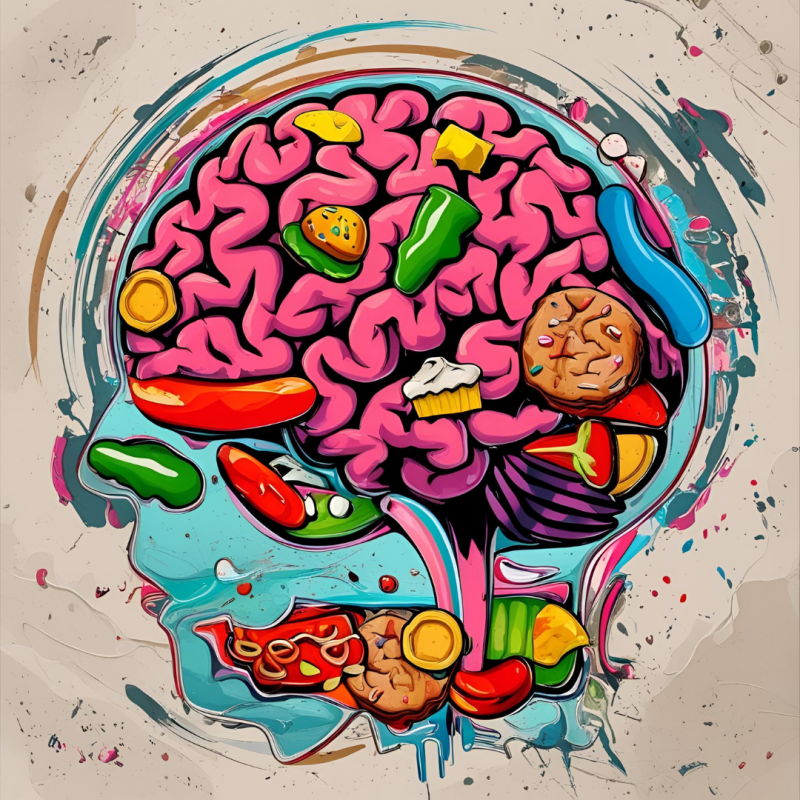Artstract by M. Shercliffe.
We’ve all heard it before: obesity is an equation of calories in versus calories out. To lose weight you merely need to eat less and exercise more. Pretty simple, right? However, the reality is far more complex. Emerging research reveals that the brain, particularly the hypothalamus, plays a central role in metabolic regulation and that inflammation in this region may be a key driver of obesity and its associated diseases. A 2017 review entitled “Hypothalamic Inflammation in Obesity and Metabolic Disease” [1] synthesizes groundbreaking findings on how hypothalamic inflammation disrupts energy balance, promotes overeating, and contributes to insulin resistance. This blog post will highlight the review, exploring the molecular and cellular mechanisms behind these processes and why they matter for understanding, and hopefully treating, metabolic disorders.
The Hypothalamus: Master Regulator of Metabolism
The hypothalamus is the brain’s metabolic control center. Nestled deep within the brain, it integrates hormonal and nutrient signals to regulate hunger, energy expenditure, and glucose metabolism. Two key neuronal populations in the arcuate nucleus of the hypothalamus are critical for this balance:
- AgRP/NPY neurons: Promote hunger and reduce energy expenditure.
- POMC neurons: Suppress appetite and increase energy expenditure.
These neurons respond to hormones like leptin and insulin, which communicate the body’s energy status. In a healthy system, rising leptin (from fat stores) and insulin (from food) activate POMC neurons and inhibit AgRP neurons, curbing appetite and boosting metabolism[1]. However, in obesity, this system breaks down due to a phenomenon known as leptin and insulin resistance, as illustrated below in Figure 1.

The Culprit: Hypothalamic Inflammation
Unlike systemic inflammation, which arises later in obesity, hypothalamic inflammation kicks in early, often before significant weight gain. Here’s how it happens:
- The Trigger? Saturated Fats.
A high-fat diet (HFD), particularly one rich in saturated fatty acids, rapidly activates inflammatory pathways in the hypothalamus. Saturated fatty acids cross the blood-brain barrier and:
- Activate Toll-like receptor 4 (TLR4) and MyD88, triggering NF-kB and JNK signaling.
- Induce endoplasmic reticulum stress, which further disrupts insulin and leptin signaling[1].
These pathways converge to promote leptin and insulin resistance in AgRP and POMC neurons, blunting their response to hormonal signals.
- The Vicious Cycle of Inflammation and Overeating
Once inflammation takes hold, it creates a feedback loop:
- Impaired POMC function leads to reduced a-MSH (an appetite suppressant) and increased B-endorphin (which may paradoxically promote cravings).
- Hyperactive AgRP neurons cause enhanced hunger signaling and reduced energy expenditure.
- HFD reduces inhibitory synapses on POMC neurons, further disinhibiting hunger[1].
The result? The brain no longer “hears” signals to stop eating, leading to uncontrolled calorie intake.
- Non-Neuronal Factors: Microglia and Astrocytes
Neurons aren’t the only cells involved. The hypothalamus is rich in glial cells, and HFD throws them into disarray:
- Microglia become activated, releasing pro-inflammatory cytokines which exacerbate neuronal dysfunction.
- Astrocytes (which help support neuronal metabolism) also release pro-inflammatory factors and induce RNA stress in the hypothalamus, amplifying the inflammatory response[1].

From Brain to Body: Systemic Consequences
Hypothalamic inflammation doesn’t just affect appetite, it has drastic metabolic consequences:
- Peripheral Insulin Resistance: Hypothalamic inflammation impairs the brain’s ability to regulate liver glucose production and adipose tissue lipolysis, worsening systemic insulin resistance.
- Autonomic Dysregulation: Altered signaling to the sympathetic nervous system reduces thermogenesis and promotes fat storage.
- Maternal Programming: Maternal obesity or HFD consumption can “imprint” hypothalamic inflammation in children, predisposing them to metabolic dysfunction later in life[1].

Therapeutic Implications: Can We Target Hypothalamic Inflammation?
The good news? Understanding these mechanisms opens doors for potential interventions, including:
- Anti-inflammatory agents: Blocking TNF-a or TLR4 signaling in the hypothalamus restores leptin sensitivity in animal models[4].
- Omega-3 fatty acids: Unsaturated fats counteract saturated fatty acid-induced inflammation[5].
- Exercise: Reduces hypothalamic inflammation by dampening NF-kB and endoplasmic reticulum stress[6].
However, translating these findings to humans remains a challenge, and more research is needed to develop targeted therapies.
The hypothalamus isn’t just a passive responder to obesity, it’s an active player in its development. By disrupting hormonal signaling, synaptic plasticity, and even the brain’s immune environment, hypothalamic inflammation locks the body into a state of metabolic dysfunction. This research shifts the narrative of obesity from mere overeating and under-exercising to a complex neurological disorder, offering new hope for treatments that target the brain to break the cycle. These findings serve as a reminder that the brain and body are inextricably linked in health and disease, including metabolic disorders.
The hypothalamus regulates metabolism through complex interactions between POMC/AgRP neurons, glial cells, AND circulating metabolic hormones, BUT saturated fats from high-fat diets trigger hypothalamic inflammation through TLR4/NF-kB activation, ER stress, and microglial overactivation that disrupts these systems, THEREFORE this creates a cycle of neuronal dysfunction, appetite dysregulation, and metabolic impairment that may require targeted anti-inflammatory interventions to break.
References
[1] A. Jais and J. C. Brüning, “Hypothalamic inflammation in obesity and metabolic disease,” J. Clin. Invest., vol. 127, no. 1, pp. 24–32, Jan. 2017, doi: 10.1172/JCI88878.
[2] S. Dey, N. Murmu, M. Bose, S. Ghosh, and B. Giri, “Obesity and chronic leptin resistance foster insulin resistance: An analytical overview,” BLDE Univ. J. Health Sci., vol. 6, Jan. 2021, doi: 10.4103/bjhs.bjhs_29_20.
[3] “Metabolic factors in the regulation of hypothalamic innate immune responses in obesity | Experimental & Molecular Medicine.” Accessed: Apr. 22, 2025. [Online]. Available: https://www.nature.com/articles/s12276-021-00666-z
[4] S. S. da Cruz Nascimento et al., “Anti-inflammatory agents as modulators of the inflammation in adipose tissue: A systematic review,” PLoS ONE, vol. 17, no. 9, p. e0273942, Sep. 2022, doi: 10.1371/journal.pone.0273942.
[5] K. Albracht-Schulte et al., “Omega-3 fatty acids in obesity and metabolic syndrome: a mechanistic update,” J. Nutr. Biochem., vol. 58, pp. 1–16, Aug. 2018, doi: 10.1016/j.jnutbio.2018.02.012.
[6] L. Della Guardia and R. Codella, “Exercise Restores Hypothalamic Health in Obesity by Reshaping the Inflammatory Network,” Antioxidants, vol. 12, no. 2, p. 297, Jan. 2023, doi: 10.3390/antiox12020297.
